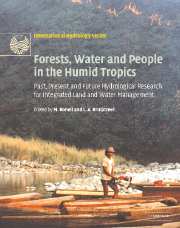 Forests, Water and People in the Humid Tropics
Forests, Water and People in the Humid Tropics Book contents
- Frontmatter
- Contents
- List of contributors
- Foreword
- Preface
- Acknowledgements
- Symposium and Workshop
- Introduction
- Part I Current trends and perspectives on people–land use–water issues
- 1 Trends and patterns of tropical land use change
- 2 The myth of efficiency through market economics: a biophysical analysis of tropical economies, especially with respect to energy, forests and water
- 3 Impacts of land cover change in the Brazilian Amazon: a resource manager's perspective
- 4 Forest people and changing tropical forestland use in tropical Asia
- 5 People in tropical forests: problem or solution?
- 6 Useful myths and intractable truths: the politics of the link between forests and water in Central America
- 7 Land use, hydrological function and economic valuation
- 8 Water resources management policy responses to land cover change in South East Asian river basins
- 9 Community-based hydrological and water quality assessments in Mindanao, Philippines
- Part II Hydrological processes in undisturbed forests
- Part III Forest disturbance, conversion and recovery
- Part IV New methods for evaluating effects of land-use change
- Part V Critical appraisals of best management practices
- Conclusion: Forests, water and people in the humid tropics: an emerging view
- Plate section
- References
9 - Community-based hydrological and water quality assessments in Mindanao, Philippines
from Part I - Current trends and perspectives on people–land use–water issues
Published online by Cambridge University Press: 12 January 2010
- Frontmatter
- Contents
- List of contributors
- Foreword
- Preface
- Acknowledgements
- Symposium and Workshop
- Introduction
- Part I Current trends and perspectives on people–land use–water issues
- 1 Trends and patterns of tropical land use change
- 2 The myth of efficiency through market economics: a biophysical analysis of tropical economies, especially with respect to energy, forests and water
- 3 Impacts of land cover change in the Brazilian Amazon: a resource manager's perspective
- 4 Forest people and changing tropical forestland use in tropical Asia
- 5 People in tropical forests: problem or solution?
- 6 Useful myths and intractable truths: the politics of the link between forests and water in Central America
- 7 Land use, hydrological function and economic valuation
- 8 Water resources management policy responses to land cover change in South East Asian river basins
- 9 Community-based hydrological and water quality assessments in Mindanao, Philippines
- Part II Hydrological processes in undisturbed forests
- Part III Forest disturbance, conversion and recovery
- Part IV New methods for evaluating effects of land-use change
- Part V Critical appraisals of best management practices
- Conclusion: Forests, water and people in the humid tropics: an emerging view
- Plate section
- References
Summary
INTRODUCTION
Philippine water issues
In spite of the fact that the Philippines is water rich, with nearly 5000 cubic metres per capita of renewable water resources, there is a national crisis regarding conservation of a dwindling supply of high quality water. This has led to presidential decrees and other legislative action at the federal level, including Senate Bill No. 1082 which is designed to institute ‘a comprehensive water development act thereby revising and consolidating all the laws governing the appropriation, utilisation, exploitation, conservation, development and management of water resources, creating the National Water Commission’ (Policy Forum, 1997).
Water quality of both coastal marine and inland freshwater environments of the Philippines is threatened by soil erosion and sedimentation, excess nutrient runoff and bacterial contamination. These types of pollutants often come from broad areas of both rural and urban land (usually classified as polluted runoff or non-point source pollution). Although polluted runoff is the most common source of water degradation in the Philippines and worldwide, it is much more difficult to control than pollution from specific sources.
As in most parts of the developing world, there is a limit to what government can do to protect and conserve water because of a lack of personnel, equipment and finances. This is especially true in remote, rural areas where rates of natural resource loss generally exceed local governments' attempts to remedy environmental problems. In particular, specific information of water conditions needed to establish management strategies is generally lacking.
- Type
- Chapter
- Information
- Forests, Water and People in the Humid TropicsPast, Present and Future Hydrological Research for Integrated Land and Water Management, pp. 134 - 150Publisher: Cambridge University PressPrint publication year: 2005
References
- 8
- Cited by


